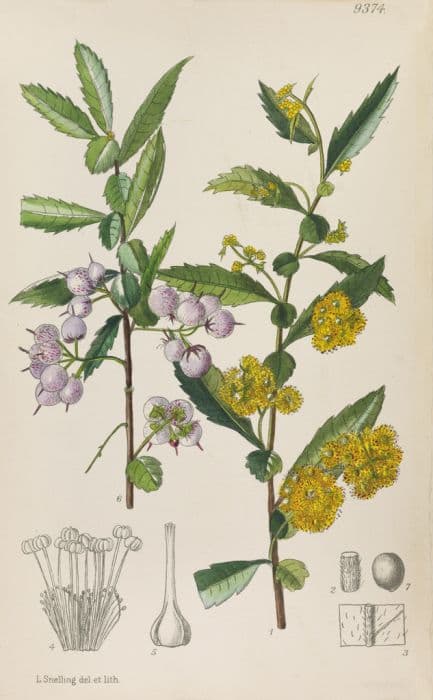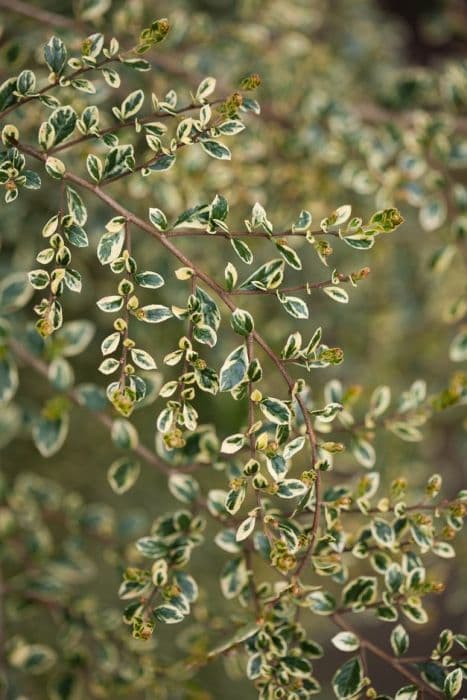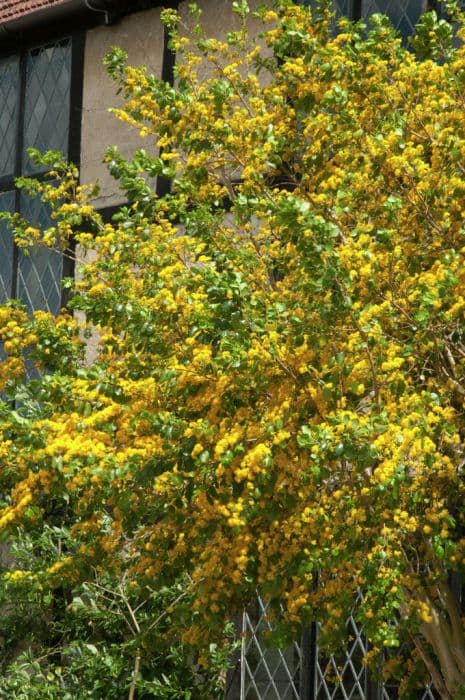Netleaf Willow Salix reticulata

ABOUT
Salix reticulata, commonly known as the netleaf willow, is a small shrub characterized by its distinctive leaves and growth habit. The netleaf willow sports shiny, green leaves marked with a pronounced network of deep veins, giving rise to its common name. The leaves are relatively small with a rounded to slightly elongated shape and toothed edges that may be curled under. As the plant matures, these leaves develop a thickened, leathery texture, providing the plant with a tough resilience to harsh conditions. The branches of the netleaf willow have a tendency to grow low to the ground, and they may sprawl or form a dense, compact arrangement. The bark on older branches and the main stem is generally grayish-brown and develops a rough, textured appearance over time. During the blooming period, the netleaf willow produces catkins, which are conspicuous flowering spikes that carry either male or female flowers, depending on the sex of the plant. These catkins add to the visual interest of the plant, emerging before the leaves in early spring. The male catkins are typically longer and more ornamental, while the female catkins are shorter and will eventually form small capsules containing seeds if pollination occurs. Overall, the netleaf willow's appearance is characterized by its interesting leaf texture, low-lying branching pattern, and attractive spring catkins. Despite its modest stature, this plant is often sought after for its intricate leaf pattern and adaptability to different environments.
About this plant
 Names
NamesFamily
Salicaceae.
Synonyms
Netleaf Willow, Reticulate Willow, Snow Willow, Netzblatt-Weide.
Common names
Salix reticulata subsp. reticulata, Salix bicolor, Salix reticulata var. bicolor, Salix nitida.
 Toxicity
ToxicityTo humans
Salix reticulata, commonly known as netleaf willow, does not have widespread recognition as a toxic plant to humans. No significant toxicity has been associated with this species, and willow species in general are known for containing salicin, a precursor to aspirin. However, excessive consumption of any plant material may lead to gastrointestinal discomfort or potential allergies in certain individuals.
To pets
Netleaf willow, the common name for Salix reticulata, is not generally recognized as toxic to pets. Willow species like the netleaf willow contain salicin, which is similar to aspirin, but this is not considered toxic at low levels. If a pet ingests a large amount of netleaf willow, they might experience mild stomach upset; however, serious poisoning is rare. Always exercise caution and consult a veterinarian if you suspect your pet has ingested a potentially harmful substance.
 Characteristics
CharacteristicsLife cycle
Perennials
Foliage type
Deciduous
Color of leaves
Green
Flower color
Yellow
Height
1 foot (30 centimeters)
Spread
2 feet (60 centimeters)
Plant type
Shrub
Hardiness zones
6
Native area
Arctic
Benefits
 General Benefits
General Benefits- Ecosystem Support: Salix reticulata, commonly known as netleaf willow, provides essential habitat and food for a variety of wildlife, particularly pollinators and birds.
- Soil Stabilization: This plant's extensive root system helps to stabilize soil and prevent erosion, particularly in riparian zones and on slopes.
- Hydrological Benefits: Netleaf willow plays a role in maintaining water cycles, as they can absorb excess water in wet conditions, reducing flood risk, and release it during drier periods.
- Climate Resilience: Adapted to cold, alpine environments, Salix reticulata can survive in harsh conditions, making it a good species for reclamation projects in challenging climates.
- Landscape Aesthetics: With its distinctive reticulated leaves and ability to form dense thickets, it can contribute to the visual appeal of natural landscapes.
- Biodiversity Promotion: Acting as a pioneer species, netleaf willow can create a more hospitable environment for other plants to colonize, enhancing overall biodiversity.
 Medical Properties
Medical Properties- Analgesic: Salix reticulata contains salicin, which may have pain-relieving properties.
- Anti-inflammatory: The plant has been traditionally used to reduce inflammation, potentially due to the salicin content, which is a precursor to aspirin.
- Antipyretic: Salix reticulata might be used to reduce fever, similar to how aspirin works.
 Air-purifying Qualities
Air-purifying QualitiesThis plant is not specifically known for air purifying qualities.
 Other Uses
Other Uses- The leaves of Salix reticulata, commonly known as net-leaved willow, have been used traditionally to fill small pillows and mattresses, providing a fragrant bedding material.
- Due to its dense and intricate branching pattern, the net-leaved willow can serve as a natural windbreak, especially in alpine gardens or in harsh, windy environments.
- The tough, pliable twigs of net-leaved willow are sometimes utilized in basket weaving and crafting small decorative objects.
- Net-leaved willow, being a dwarf shrub, is often planted in rock gardens for its textured foliage and attractive growth habit.
- Traditionally, the flexible branches of the net-leaved willow have been used as binding material for construction or in the creation of fish traps by indigenous peoples.
- The plant's ability to grow in poor soil makes it suitable for soil stabilization projects and reclamation of disturbed sites such as mine tailings.
- Some cultures use the barks and twigs of the net-leaved willow to create natural dyes for fabric and handicrafts.
- In bonsai cultivation, the net-leaved willow is sometimes chosen for its miniature foliage and capability to be shaped, though it is not a common species for this purpose.
- The net-leaved willow plays a role in supporting local wildlife, providing a habitat and food source for various insects and birds.
- Given its often limited size, the net-leaved willow is appropriate for container gardening and can be grown in small spaces such as balconies or patios.
Interesting Facts
 Feng Shui
Feng ShuiThe netleaf willow is not used in Feng Shui practice.
 Zodiac Sign Compitability
Zodiac Sign CompitabilityThe netleaf willow is not used in astrology practice.
 Plant Symbolism
Plant Symbolism- Flexibility: The Salix reticulata, commonly known as the netleaf willow, has branches that are flexible and can bend without breaking. It symbolizes the ability to adapt and be resilient in the face of adversity.
- Healing: Willow species have been used for their medicinal properties for centuries, thus the netleaf willow can be associated with healing and the soothing of pain.
- Growth: As willows are fast-growing plants, the netleaf willow is often associated with growth and the ability to thrive in challenging conditions.
- Survival: The netleaf willow is capable of surviving in high altitudes and tough environments, symbolizing endurance and the strength to overcome challenges.
- Renewal: Willows are among the first plants to leaf out in the spring, which makes them a symbol of new beginnings and renewal.
 Water
WaterFor the Snow Willow, it's crucial to maintain evenly moist soil throughout the growing season. Watering should generally take place a few times a week, depending on weather conditions. However, you should adjust your watering schedule to account for rainfall and avoid waterlogging the soil. A good approach is to provide the Snow Willow with about 2 gallons of water per week, checking the soil moisture level between waterings. During the winter dormancy period, reduce watering significantly, but ensure the soil doesn't completely dry out.
 Light
LightThe Snow Willow prefers full sun to partial shade conditions. When choosing a spot, ensure that it gets at least 6 hours of direct sunlight a day, although it can tolerate some dappled shade, especially in hotter climates. The plant thrives best with morning sunlight and some protection from the intense afternoon sun.
 Temperature
TemperatureThe Snow Willow does well in a wide range of temperatures, but it prefers cooler conditions. It can survive minimum temperatures down to about -40 degrees Fahrenheit and can handle summer highs up to 80 degrees Fahrenheit. Ideally, it thrives in a climate where the average temperature is below 70 degrees Fahrenheit, maintaining its health and promoting good growth.
 Pruning
PruningPruning the Snow Willow is essential for maintaining its shape and encouraging healthy growth. Prune in late winter or early spring before new growth begins. Remove any dead or damaged branches, and thin out overgrown areas to improve air circulation. Pruning every year or two helps to rejuvenate the plant and keeps it looking its best.
 Cleaning
CleaningAs needed
 Soil
SoilThe net-leaved willow prefers moist, well-draining soil rich in organic matter with a soil pH of 6.0 to 7.5. The best soil mix might include peat, loamy soil, and sand to ensure proper drainage and aeration.
 Repotting
RepottingThe net-leaved willow, being a small, slow-growing plant does not require frequent repotting. It can be repotted every 2-3 years or when it has visibly outgrown its current container.
 Humidity & Misting
Humidity & MistingThe net-leaved willow thrives at higher humidity levels but can adapt to normal outdoor humidity. If grown indoors, maintaining humidity levels of 40-60% is beneficial for the plant.
 Suitable locations
Suitable locationsIndoor
Plant in moist soil, bright indirect light, and maintain cool temperatures.
Outdoor
Plant in moist soil, partial shade to full sun, protect from strong winds.
Hardiness zone
2-6 USDA
 Life cycle
Life cycleSalix reticulata, commonly known as netleaf willow, begins its life cycle as a seed, which germinates in moist soil conditions in the spring or early summer. After germination, the seedling emerges, rapidly developing a root system and a stem that supports simple leaves. The plant enters a vegetative growth phase where it forms a low, mat-like shrub due to its dwarf stature and harsh alpine or subalpine environment; it continues to grow and spread primarily by producing new stems and leaves. As it matures, typically after a few years, it starts to produce flowers; male and female flowers are borne on separate plants (dioecious). Following pollination, usually by insects, the female plants develop capsules which contain numerous tiny, fluffy seeds that are dispersed by wind, allowing the plant to colonize new areas. The netleaf willow has a perennial growth habit, surviving through the winter months with buds near the surface and resuming growth each spring.
 Propogation
PropogationPropogation time
Spring-Early Summer
The most popular method of propagating the netleaf willow, which is the common name for Salix reticulata, is through hardwood cuttings. This is generally done in late winter when the tree is dormant, just before spring growth begins. To propagate, you first take cuttings from mature branches, ideally those that are about the thickness of a pencil (roughly 1/4 to 1/2 inch or 6-12 mm in diameter) and about 6 to 10 inches (15-25 cm) long. One should then remove the leaves and plant the cuttings directly into the ground where they are to grow, or into pots filled with soil mix. The cut ends should be dipped in rooting hormone to encourage root development before planting. Keep the soil moist until the cuttings are well-rooted, which may take several weeks to a few months. With proper care, these cuttings will develop into new willow shrubs.









